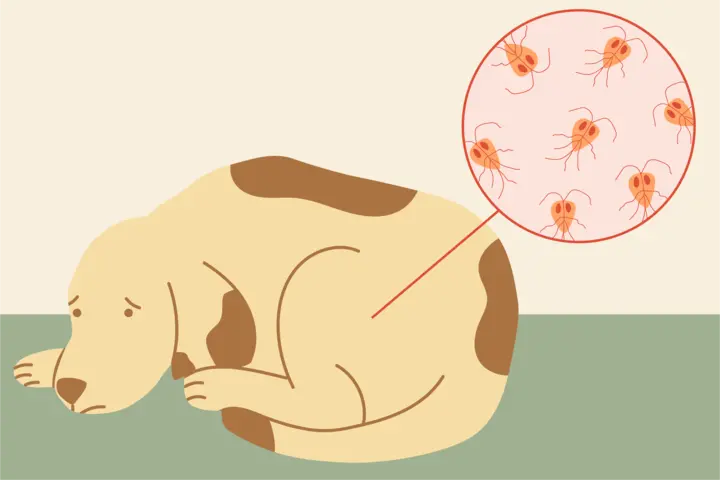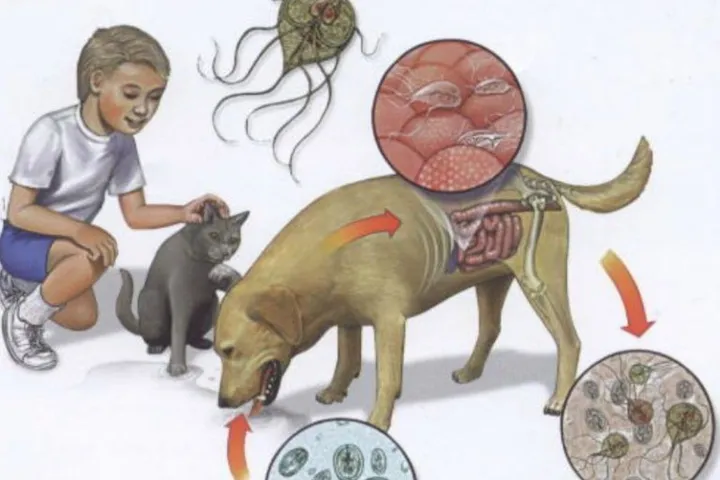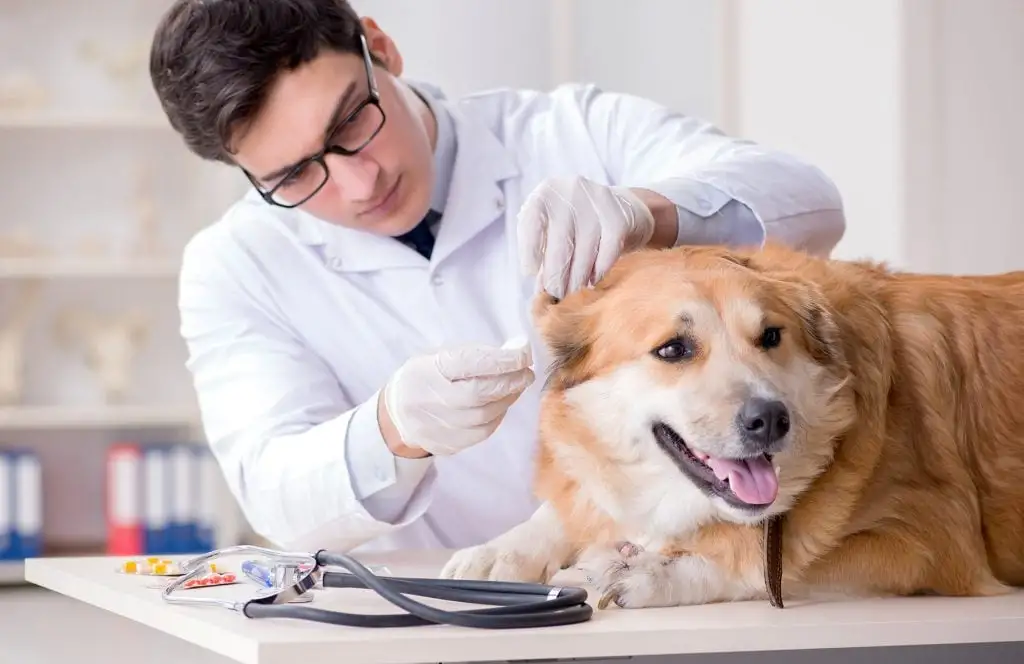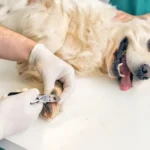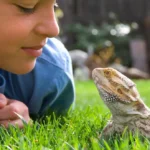Is your furry friend feeling under the weather? Giardia might be the culprit. This pesky parasite can wreak havoc on your dog’s digestive system, causing a range of uncomfortable symptoms. But don’t worry with the right knowledge and treatment, you can help your canine companion bounce back to health. In this comprehensive guide, we’ll dive into the world of giardia in dogs, exploring everything from symptoms to treatment options and prevention strategies.
What Is Giardia and How Do Dogs Get It?
Giardia is a microscopic parasite that sets up shop in the intestines of dogs (and many other animals, including humans). This single-celled troublemaker is a master of survival, able to live in the environment for months under the right conditions. But how exactly does it find its way into our four-legged friends?
Understanding the Giardia Parasite
Giardia exists in two forms: the active, swimming trophozoite that causes infection, and the hardy, egg-like cyst that spreads the parasite. These cysts are tough cookies, resistant to many environmental factors and ready to infect a new host when ingested.
Common Transmission Routes for Dogs
Dogs typically contract giardia by:
- Drinking contaminated water from puddles, streams, or lakes
- Ingesting cysts from contaminated soil or grass
- Licking their paws after walking in infected areas
- Coming into contact with the feces of an infected animal
Risk Factors: Is Your Pup More Susceptible?
While any dog can get giardia, some factors increase the risk:
- Puppies and senior dogs (due to less robust immune systems)
- Dogs in crowded environments like kennels or shelters
- Frequent visitors to dog parks or daycare centers
- Dogs with compromised immune systems
Did you know? Giardia is so prevalent that some studies estimate up to 7% of dogs in North America may be infected at any given time.
Recognizing the Signs: Symptoms of Giardia in Dogs
Giardia is a sneaky parasite – not all infected dogs show symptoms. But when they do, it’s usually not pretty. Here’s what to watch for:
Gastrointestinal Distress: More Than Just an Upset Tummy
- Diarrhea: Often the hallmark symptom, ranging from soft to watery
- Greenish stool: Sometimes with a mucusy or fatty appearance
- Vomiting: Less common but can occur in some cases
- Weight loss: Due to malabsorption of nutrients
- Dehydration: A dangerous consequence of prolonged diarrhea
Behavioral Changes to Watch For
- Lethargy or decreased energy levels
- Loss of appetite
- Increased irritability
- Abdominal discomfort (your dog may whine or resist being touched on the belly)
When to Call the Vet: Red Flags You Shouldn’t Ignore
While mild cases of giardia might resolve on their own, certain symptoms warrant immediate veterinary attention:
- Bloody diarrhea
- Severe vomiting
- Signs of dehydration (sunken eyes, dry gums, loss of skin elasticity)
- Fever
- Extreme lethargy or collapse
“Giardia can be tricky to diagnose without proper testing. If your dog is showing persistent gastrointestinal symptoms, it’s always best to consult with your veterinarian.” – Dr. Sarah Thompson, DVM
Diagnosing Giardia: What to Expect at the Vet’s Office
When you bring your pup in for suspected giardia, your vet will likely start with a thorough physical examination and history. But the real detective work happens under the microscope.
Fecal Tests: The Go-To Diagnostic Tool
Your vet will probably request a fresh stool sample. Here’s what they might do with it:
- Direct smear: A quick look for swimming trophozoites
- Fecal flotation: Concentrates cysts for easier detection
- ELISA test: Detects giardia-specific proteins in the stool
Other Potential Tests Your Vet Might Recommend
- Blood tests to check for signs of dehydration or other health issues
- X-rays or ultrasound if other gastrointestinal problems are suspected
The Importance of Accurate Diagnosis for Effective Treatment
Giardia can be tricky to spot, often requiring multiple tests over several days. This persistence is crucial because:
- Cysts are shed intermittently, so a single negative test doesn’t rule out infection
- Other parasites or health issues can cause similar symptoms
- Proper identification ensures the most effective treatment plan
Treating Giardia in Dogs: A Multi-Pronged Approach
Once giardia is confirmed, it’s time to kick this parasite to the curb. Treatment typically involves a combination of medication, supportive care, and environmental management.
Medication Options: Prescription Drugs That Pack a Punch
| Medication | Common Dosage | Duration | Notes |
|---|---|---|---|
| Metronidazole | 15-25 mg/kg twice daily | 5-7 days | May cause nausea in some dogs |
| Fenbendazole | 50 mg/kg once daily | 3-5 days | Generally well-tolerated |
| Combination therapy | Varies | 5-10 days | Used for stubborn cases |
Metronidazole: The First Line of Defense
This antibiotic has been a go-to for giardia treatment for years. It works by disrupting the parasite’s ability to reproduce. While effective, it can have some side effects, including:
- Nausea or vomiting
- Loss of appetite
- Darkened urine
Fenbendazole: A Powerful Alternative
Originally developed as a dewormer, fenbendazole has shown great promise in treating giardia. It’s often preferred for its milder side effect profile and effectiveness against other intestinal parasites.
Combination Therapies: When One Drug Isn’t Enough
For tough cases or in kennels where reinfection is a concern, vets might prescribe a combination of metronidazole and fenbendazole. This one-two punch can be particularly effective at clearing stubborn infections.
Supportive Care: Helping Your Dog Feel Better During Treatment
Medication is just part of the battle. Here’s how you can support your pup’s recovery:
Dietary Adjustments to Soothe the Digestive System
- Bland diet: Temporarily switch to easily digestible foods like boiled chicken and rice
- Small, frequent meals: Easier on the irritated gut
- Fiber supplements: Can help firm up loose stools (consult your vet first)
Probiotics: Restoring Gut Health
Beneficial bacteria can help restore balance to your dog’s digestive system. Look for products specifically formulated for dogs, and continue use for several weeks after treatment.
Hydration: Keeping the Fluids Flowing
Diarrhea can quickly lead to dehydration. Encourage water intake and consider pet-friendly electrolyte solutions if needed.
Environmental Management: Stopping the Spread in Its Tracks
Giardia is a tough cookie, but with diligence, you can prevent reinfection:
Cleaning and Disinfecting: Your New Best Friends
- Steam clean carpets and upholstery
- Wash bedding in hot water
- Disinfect food and water bowls daily
- Clean up outdoor areas where your dog eliminates
Bathing Your Dog: More Than Just a Spa Day
Give your pup a thorough bath, paying special attention to the hind end, to remove any lingering cysts from the fur.
The Road to Recovery: What to Expect During Giardia Treatment
Patience is key when treating giardia. Here’s a typical timeline:
- Days 1-3: Start of medication, may see initial improvement in symptoms
- Days 4-7: Continued improvement, stools should start to firm up
- Days 8-14: Most dogs will be symptom-free by this point
- 2-4 weeks post-treatment: Follow-up testing to confirm clearance of infection
Potential Challenges and Setbacks
- Reinfection: Especially common in multi-pet households or areas with high environmental contamination
- Resistant strains: Some giardia may not respond to initial treatment
- Underlying health issues: Giardia can be more persistent in dogs with compromised immune systems
Follow-Up Testing: Ensuring the Giardia Is Gone for Good
Your vet will likely recommend retesting 2-4 weeks after treatment. This is crucial because:
- Giardia can be hard to eliminate completely
- Some dogs can become asymptomatic carriers
- Early detection of reinfection prevents another full-blown outbreak
Prevention: Keeping Giardia at Bay
An ounce of prevention is worth a pound of cure, especially when it comes to giardia. Here are some tips to keep your pup parasite-free:
Hygiene Habits That Make a Difference
- Regular hand washing: After handling your dog, especially before eating
- Prompt poop pickup: Don’t let those cysts linger in the environment
- Separate water bowls: If you have multiple pets
Water and Food Safety: Reducing Risk at Home and Away
- Fresh, clean water: Change it daily and clean bowls regularly
- Avoid standing water: No drinking from puddles or ponds on walks
- Travel smart: Bring your own water and bowls on trips
Regular Check-Ups: Your Vet’s Role in Giardia Prevention
Annual or bi-annual wellness exams can catch giardia early, even in asymptomatic dogs. Consider more frequent checks if your dog is at high risk.
Giardia in Multi-Dog Households: Special Considerations
When one dog has giardia, it’s often just a matter of time before others in the household are affected. Here’s how to manage the situation:
Isolating Infected Dogs: When and How
- Separate infected dogs if possible, especially during treatment
- Use different areas for elimination to reduce environmental contamination
- Keep toys, bedding, and food/water bowls separate
Treating All Dogs: A Necessary Precaution?
Many vets recommend treating all dogs in the household, even if only one shows symptoms. This proactive approach can prevent a cycle of reinfection.
Long-Term Management Strategies
- Implement a regular deworming schedule
- Consider periodic giardia testing, especially after boarding or travel
- Maintain strict hygiene practices, even after the outbreak is over
The Human Factor: Can You Catch Giardia from Your Dog?
While it’s possible for humans to contract giardia from dogs, it’s relatively uncommon. The strains that infect dogs are usually different from those that affect humans. However, it’s not impossible, especially for people with weakened immune systems.
Zoonotic Potential: Understanding the Risks
- Children, elderly, and immunocompromised individuals are at higher risk
- Transmission usually occurs through accidental ingestion of cysts
- Proper hygiene is your best defense
Protecting Yourself and Your Family During Treatment
- Wash hands thoroughly after handling your dog or cleaning up after them
- Wear gloves when cleaning areas where your dog has eliminated
- Keep your dog away from food preparation areas
- Consider temporarily restricting your dog’s access to bedrooms
“While the risk of human infection from canine giardia is low, it’s always better to err on the side of caution. Good hygiene practices protect both you and your pet.” – Dr. Michael Chen, Veterinary Parasitologist
Conclusion: Winning the Battle Against Giardia
Giardia might be a tough opponent, but with proper treatment and care, your furry friend can bounce back to health in no time. Remember:
- Early detection is key – know the signs and don’t hesitate to consult your vet
- Follow treatment plans exactly as prescribed
- Focus on both medical treatment and environmental management
- Prevention is the best medicine – maintain good hygiene and be aware of risk factors
By staying informed and proactive, you can keep giardia at bay and ensure your pup stays happy, healthy, and ready for their next adventure.

